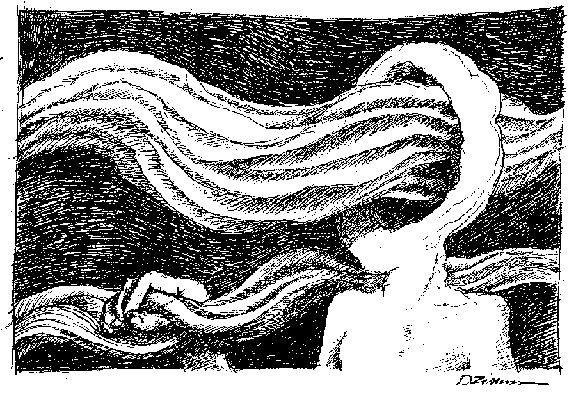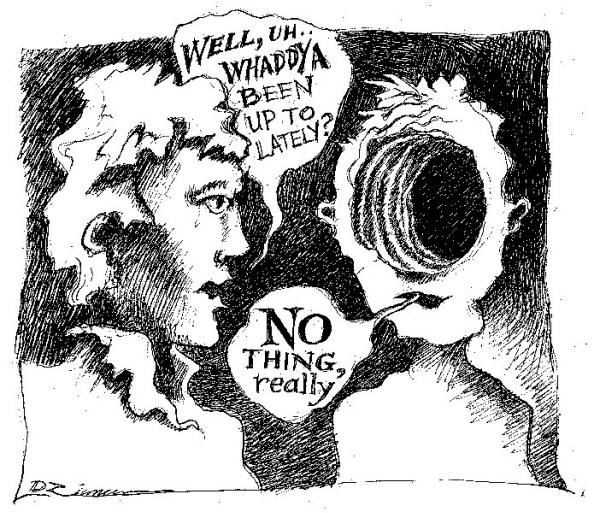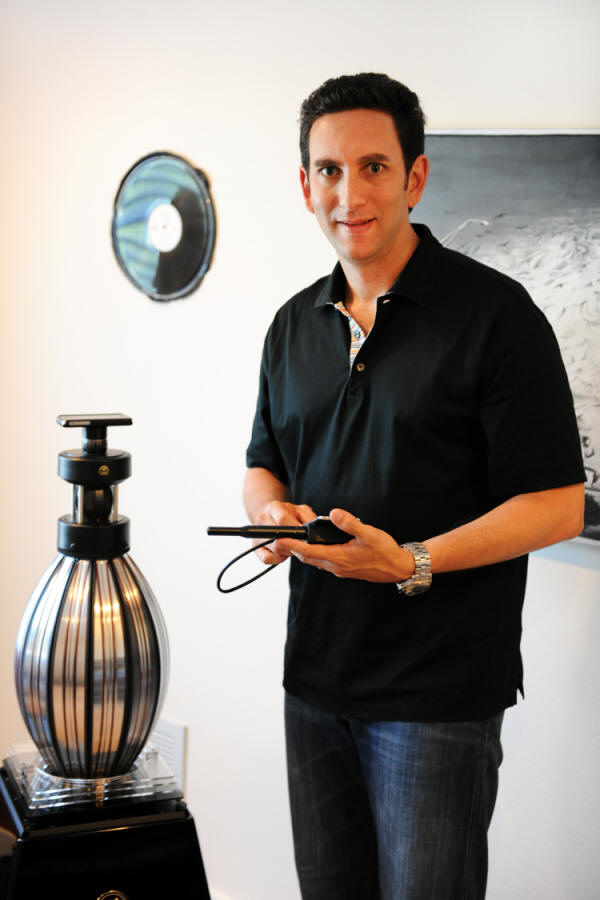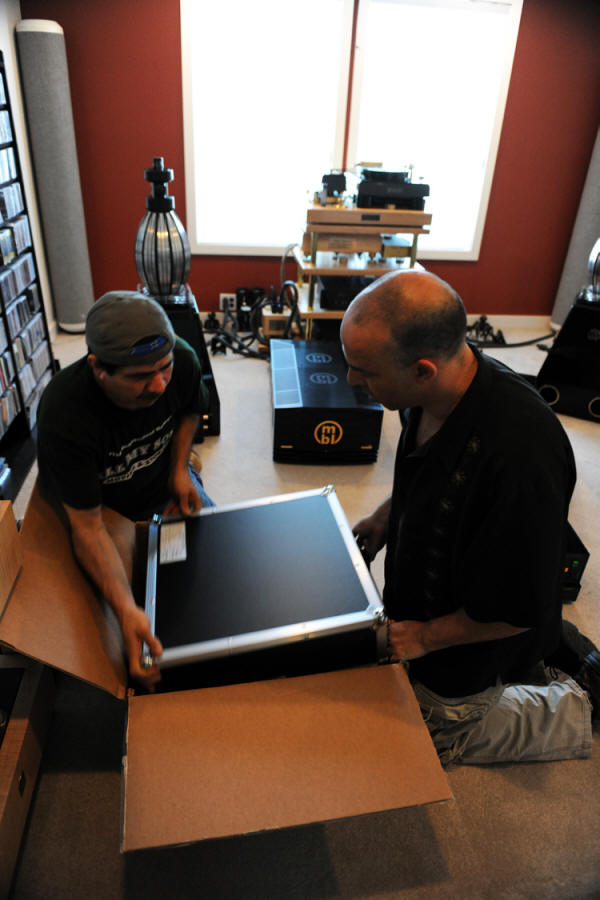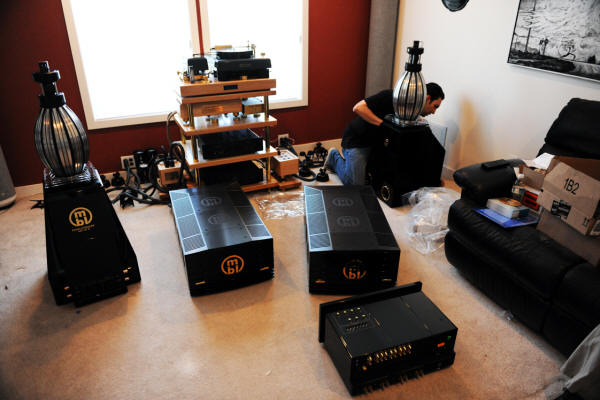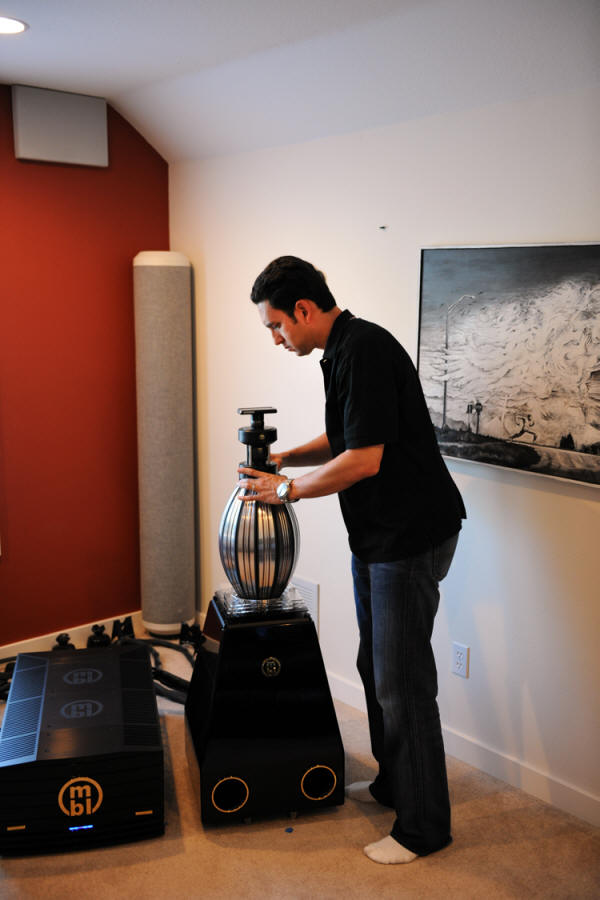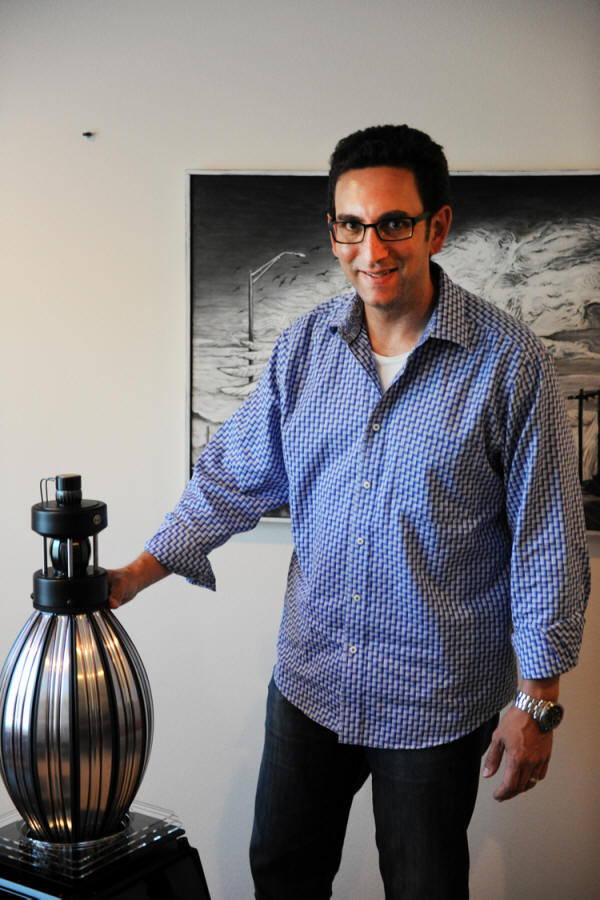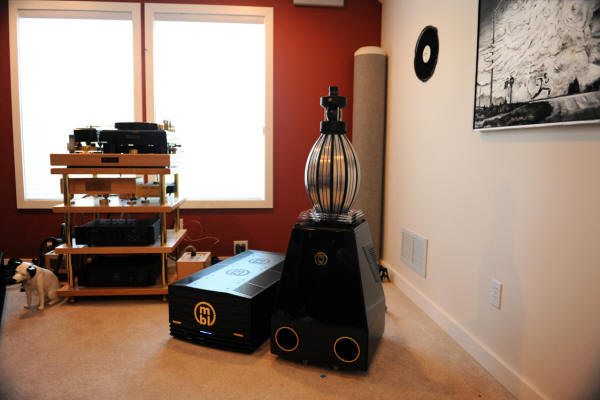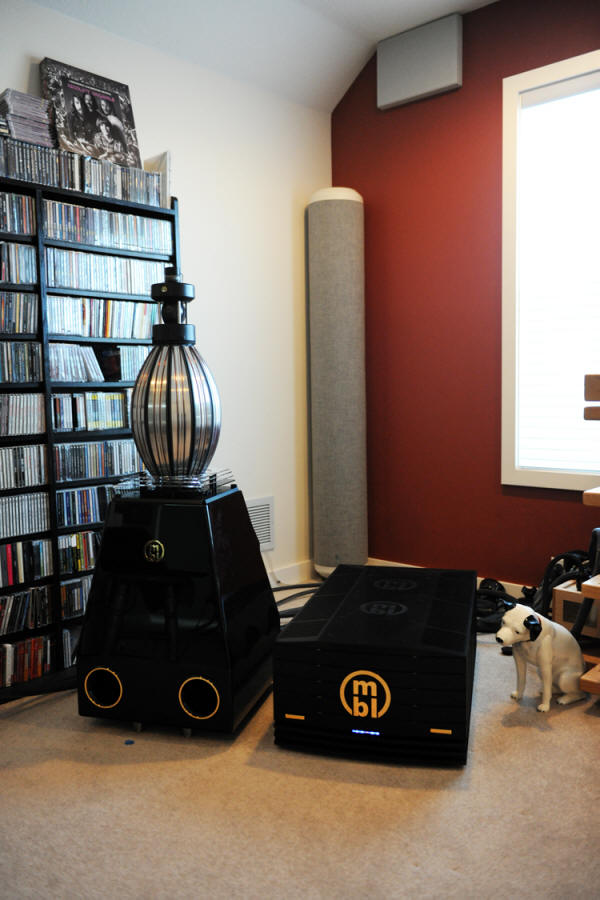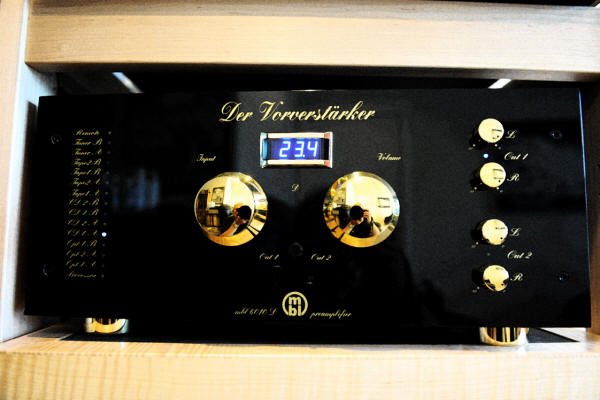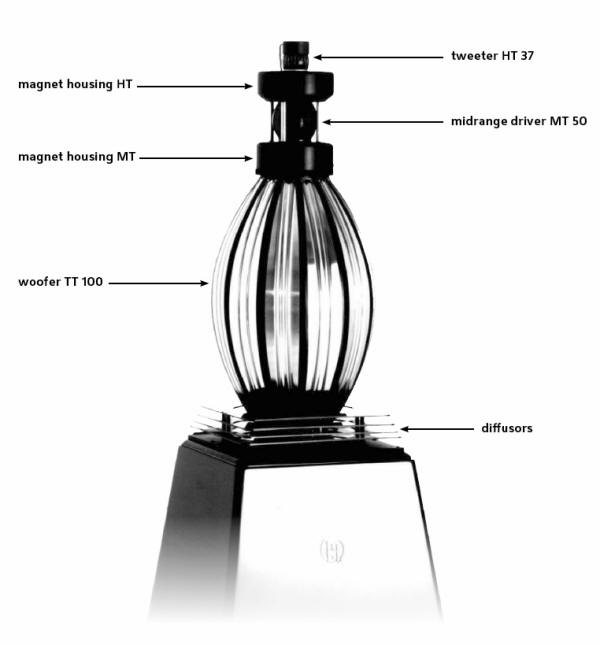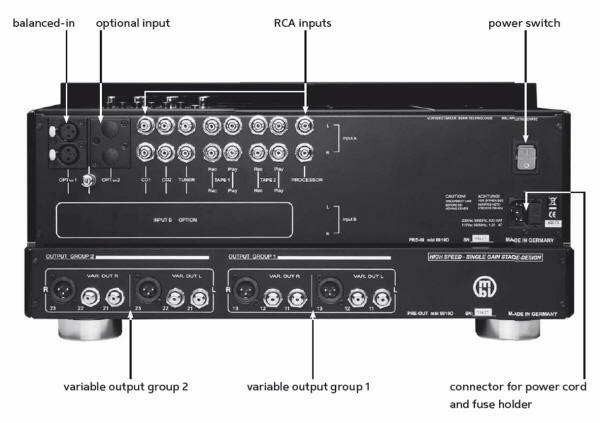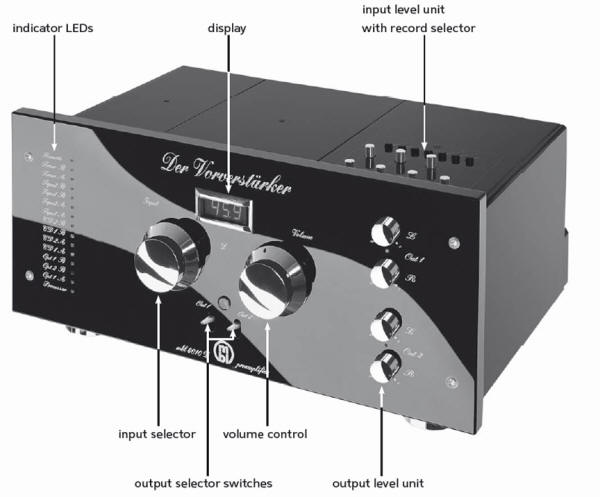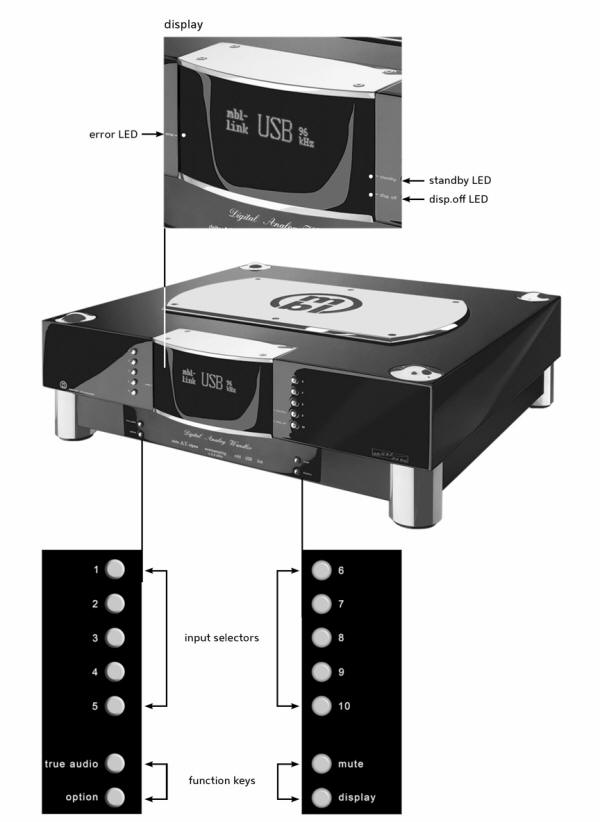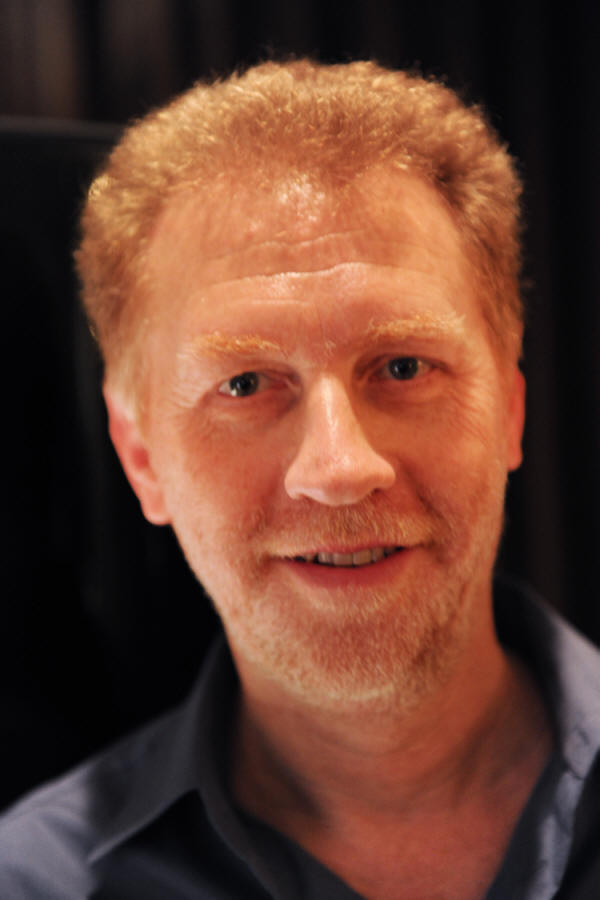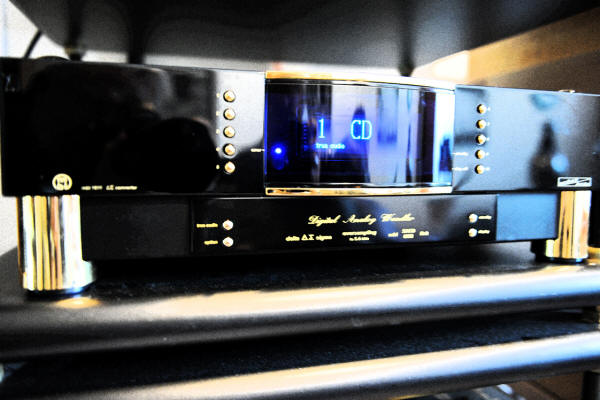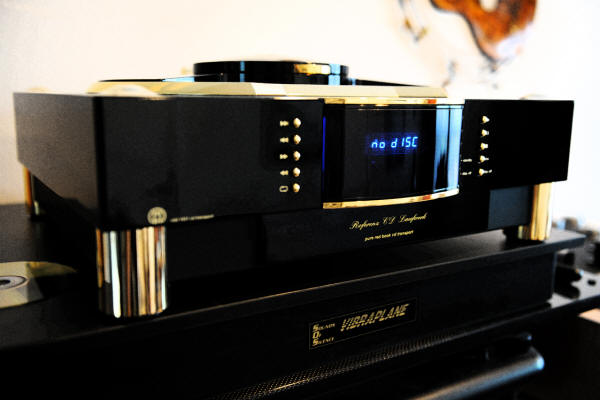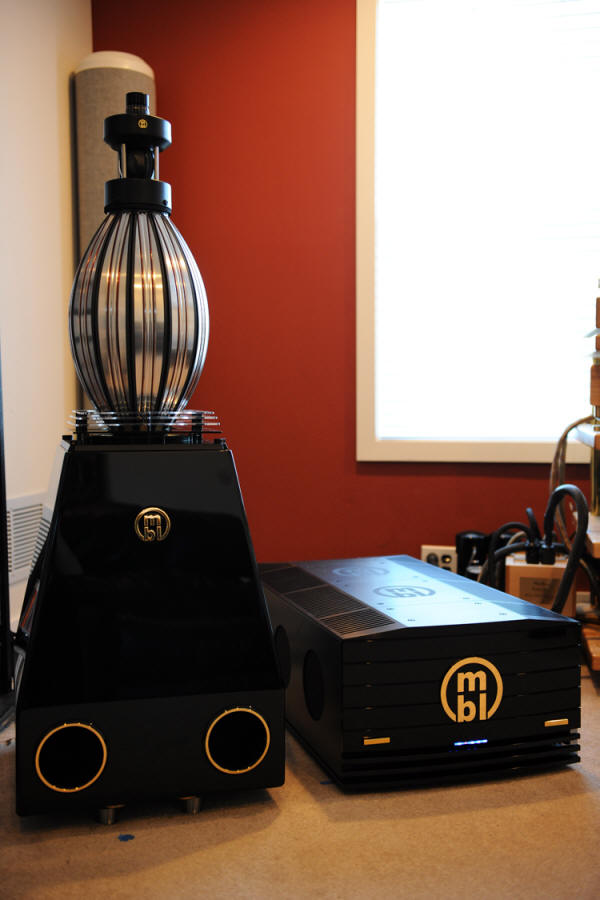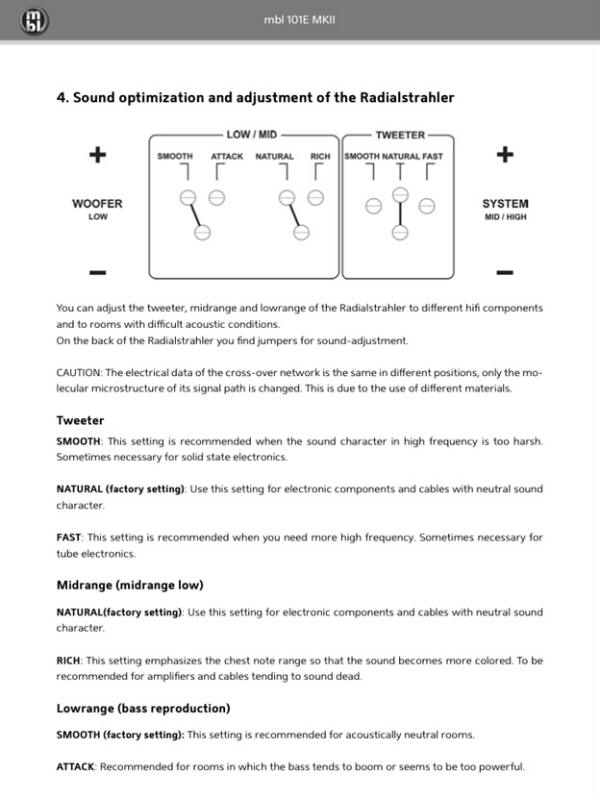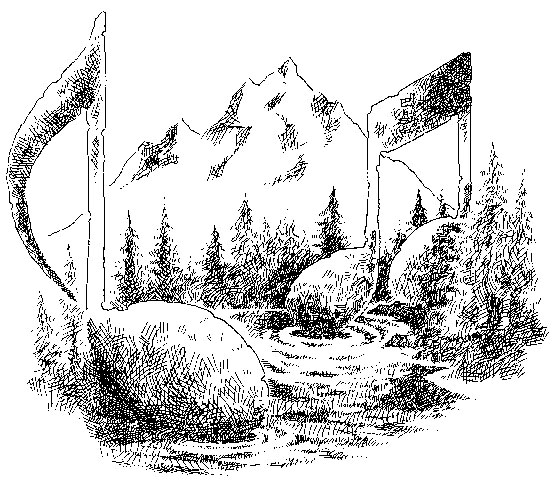You are reading the older HTML site
Positive Feedback ISSUE 73
Impressions: The MBL Reference System [All photographs and image processing by Robinson, unless otherwise noted; cartoons by Dan "The Man!" Zimmerman and Bruce Walker.]
The MBL 9011 monoblock amplifier and Radialstrahler 101E Mk. II omnidirectional loudspeaker "Great things are done by a series of small things brought together." Vincent van Gogh
Retrospection: Long Train Coming… Some review projects take longer than others to come together. A lot longer. Of course, others never come together, no matter how long you and a source talk about it. Chit-chat; tire-kicking at audio shows; variations on "You know, we really want to have you review our stuff!" Followed by the sound of crickets, or variations on "Gee, we're back ordered until [fill in the blank]!" Some folks are sincere, and missed connections are just the way that life goes; others are not serious, or are BS artists who never intend to do more than make promises without any intention of fulfilling them. (Yes, you know who you are.) It happens. But in the case of MBL, sincerity and hard work were involved for years to make this review possible. The story of the MBL Reference System goes all the way back to the fall of 2007, when I first heard an earlier iteration of the MBL Radialstrahler 101 loudspeakers (the 101E's, as I recall) at the Rocky Mountain Audio Fest of that year. It was on the last day that I attended the show, and in the late afternoon, as I was getting ready to wrap things up. Normally this is a time at which I'm pretty tired, and not really expecting to hear anything that was very impressive. I was walking down a hall, and saw that there was a room that looked pretty packed, with an overflow crowd standing in the open doorway. From the room came a sound of a piano recording…don't remember what it was…that was truly compelling. It was so good that, instead of walking on, I pushed as far into the room as I could, to hear more. I found myself in the middle of an enthralled group of people, all listening to a rich, detailed, piano recording. The weight of the instrument seemed to fill the room, with a power sense of the resonant, harmonically rich soundboard of the piano. Knockout! I couldn't really tell about soundstaging or imaging, but the tonal values and musicality were obvious. Even in an overcrowded room, against the back wall, I could tell that something special was happening. So, I stepped into the hallway and talked with MBL's short-lived representative, David Alexander, about arranging a review of the system. He was amenable, but said that it would have to be after CES 2008, the following January. We agreed to stay in touch, and see what happened after the middle of January.
The Crash and "Great Recession" of 2008: The Big NO Thing! Sure enough, it was feasible to do the project, and the MBL Radialstrahler 101E's, a pair of 9008A stereo amplifiers, and their 6010D preamp arrived in the early spring of 2008. (For the record, Jeremy Bryan of MBL notes the following about stereo vs. monoblock operation with the MBL line: "There is no "Switch" for mono…these are differential designs from the start, two identical amplifiers, one for on phase, one for off phase. When connected with a true differential source via XLR, you have the true connection. For single ended use via RCA connectors, you basically get one amp for the left channel, and the other amp for the right channel…no differential. Totally different output power, totally different distortion characteristics, totally different sound. This single ended / RCA connection was really just added to allow a customer to purchase one chassis and be able to use it (less than optimally) until he could purchase the second chassis and go differential / balanced as it was designed to be used. This is true for 9011, 9008 A, and 9007 amps from MBL.") I spent a handful of months with this system, and was impressed by it. The system stayed until the later summer of 2008, when they had to be shipped back due to my sudden move to Virginia to take a position as a college administrator there. (This didn't last long, however; the crash of the "Great Recession" of 2008 occurred during the first week that I arrived in Virginia Beach. Stock market down hundreds of points; banks and investment houses in chaos; credit markets experiencing severe sphincter pucker. The crunch made it impossible to sell my house in Portland, which meant that I couldn't buy a house in Virginia. End of plan to work for a few years in that neck of the woods. Definitely the big NO Thing!) I was taken enough with this initial MBL Reference System to give it one of my belated Brutus Awards in early 2009, just before I returned to Portland. (See Issue 41 for my comments.) This doesn't happen unless a given component or system really knocks it out of the ballpark in my own reference listening room…and the MBL had definitely done so. Normally, I would have followed up with a major review of the system after my return to Portland in 2009, but…there was a glitch. US distribution had hit a glitch, with problems between MBL in Germany and the American distributor at that time, mbl of America. Over time, the disagreement became serious, and led to confusion about how to source MBL in the USA. Now this isn't an unknown occurrence… I've experienced it with other companies… but when it does happen during one of my reviews, it derails the train. I can't do a full-scale review when I can't tell our readers in America where to go to purchase the equipment. I therefore had to set aside this project, and wait patiently for MBL to resolve the situation. Time Passes On…And Then Came Resolution As it turned out, it would take nearly three years for things to shake down. I had stayed in touch with MBL in Germany, and was informed that they were reorganizing distribution in America. A new US distribution enterprise, MBL North America (http://mbl-northamerica.com/main/) came online in February of 2011. Under the very capable leadership of its new president, Jeremy Bryan, MBL was able to provide North American customers with effective distribution and service…a great relief! Now I could move ahead with reviewing the MBL that would be able to point to North American sourcing. Jeremy and I connected, and by 2012 were able to set the plans for a full MBL Reference System project. This would include the following products:
Radialstrahler 101E Mk. II loudspeakers The summer of 2012 looked like the most likely time for the project… which is what it turned out to be.
Setup Jeremy Bryan, President of MBL North America…in the mood for system setup! Setting up an MBL reference system can be a daunting task. The number of crates wasn't so bad, but getting the Radialstrahler 101E Mk. II's (300 pounds with their their crates on; 176 pounds, undressed) up the stairs is something that calls for care and proper handling. The 9011 amplifiers are not light, either, at 275 pounds in their anvil cases… definitely not something that a single person should handle. That's why PF brings in professional movers here in River City to handle all heavy metal projects like these… my back appreciates the investment! This also left Jeremy and me free to direct unpacking and placement of the components.
Carefully unpacking the 6010D preamp; Jonathan Tinn of Blue Light Audio (right) assisting…
Jeremy Bryan working on placement of one of the Radialstrahler 101E Mk. II speakers; between are the mighty 9011 monoblocks, and, in the foreground, the 6010D preamplifier.
Jeremy fine-tuning the Radialstrahler 101E Mk. II I will say that Jeremy knows the MBL Reference line inside and out. Within just a few hours, he had the MBL gear in place; all the cabling, including double 15 Amp IEC power cords on each 9011 monoblock (courtesy of Kubala-Sosna) connected; had installed Stillpoints SS isolation feet (later upgraded to the top-of-the-line Stillpoints Ultra 5 isolation feet) and had tweaked the 101E Mk. IIs into their final placement. In a somewhat smaller space like my listening room, this calls for a degree of precision, since misplacement of only an inch or two can make a very big difference in the quality of soundstaging and imaging. Jeremy measured carefully, then he and I would place…then listen…then he would shift a bit… then listen again… and so on. Jeremy knows the speakers inside and out, and was patient as he sought to optimize their performance in our reference listening room. After several hours of work, he was satisfied.
Jeremy Bryan with the Radialstrahler 101E Mk. II The final placement had each speaker approximately 28" from the side walls. This was in a zone for speaker placement in this room that we've identified with a number of different reference speakers over the years. To the right was a flat wall surface, with a major black and white oil painting by long-time close amigo-artist Daniel Zimmerman.
Right-side placement of the 101E Mk. II speaker and 9011 monoblock. To the left is a large rack of SACDs, which acts as a very helpful diffuser. (It makes a virtue of necessity, since PF's collection of nearly 5000 SACDs has to go somewhere, dig?) The results are actually surprisingly good, enhancing the "wall-within-a-wall" on both the left and right sides of our listening room here.
Left side placement of the 101E Mk. II and 9011 monoblock; note the large rack of SACDs to that side. The 101E Mk. IIs fit into our listening room comfortably. They are good-sized speakers, but aren't so large or bulky that they are too difficult to handle. In fact, Jeremy was able to move them about with reasonable ease, with just a bit of help from me. Potential buyers for these speakers should not be too concerned about their size/weight; our moderately-sized reference room (12.5' x 13.5', with an entrance passage that extends the left side to 18', with 8' cambered ceilings) with wall-within-a-wall left and right, handled them quite comfortably. This is in part due to the 101E Mk. II's remarkable omnidirectional character, and in part to the carefully constructed and sound-treated room. The rest of the components went in without any problems, since their placement was pretty much self-evident. The 9011 monoblocks went on the floor…at 36" deep for each amplifier, they were too large for any of the amp platforms that I had…and Jeremy said that they wouldn't need the isolation, since they had this taken into account in their design. They're made to rest upon their own suspension. Good thing, since they weigh a ton! (Well, maybe more like 198 pounds per amp. Close enough.) The 1621A CD transport went on top of my trusty-rusty Vibraplane isolation platform on the Michael Green rack, while the 1611F DAC was set upon the next shelf down. The middle shelf of my Critical Mass Systems Grandmaster Black rack was occupied by the 6010D preamplifier. It had been outfitted with MBL's MC phono amp section.
The 6010D preamplifier in fresco… The overall layout was extremely attractive, with no problems whatsoever in setup or operation. I have to admit being pleased at how quickly the system dialed in. The MBL components were large and lovely to look at, but were also extremely well-engineered…and thus, very well behaved from the beginning. Hassle-free, for sure. In addition to the 1621A CD player and the 1611F DAC, the sources that we used during the course of the extended review period included the Playback Designs MPS-5 SACD/CD/DSD player with USB-X interface for USB 2.0 input, and the Wave Kinetics NVS turntable with Durand Tonearms Telos 12" tonearm and Ortofon Anna MC cartridge. Power conditioning/supply was via the PS Audio PerfectWave Power Plant P10 and a Walker Audio Velocitor. On the amplifier side, both 9011s were plugged directly to two separate fully-dedicated 20 amp circuits with Kubala-Sosna Elation! power cables (two per side). The AC receptacles used were the Tesla Flex cryo-treated, with Walker Audio Extreme SST Contact Enhancement used in the installation. The Specifications Specs: One man's ceiling is another man's floor. Sometimes they help you; other times, they don't tell you much. But in this case, key MBL specifications will help to explain why I had the really visceral, powerful response to the MBL Reference system that I did. Key specs for me:
The MBL Radialstrahler 101E Mk. II (diagram courtesy of MBL)
MBL 6010D reference preamplifier, rear view (image courtesy of MBL)
MBL 6010D reference preamplifier, front view (image courtesy of MBL)
MBL's 1621A Reference CD Transport, front and top views (images courtesy of MBL)
MBL's 1611F Delta Sigma PCM DAC (images courtesy of MBL)
Thus, my summary of the key specs. The MBL Reference System with the 101E Mk. II's chalked up as a damned potent approach to the summit of high-end audio performance. But how would it shape up in what turned out to be an extended and thorough work-out?
Jürgen Reis of MBL; a portrait by Robinson The Sound, Right Out of the Box…
Jeremy Bryan relaxes in the PFO reference listening room on his second visit, a week after the initial setup, and catches Muddy Waters Folksinger on SACD via the Playback Designs MPS-5. I started out with about a week of break-in, while Jeremy was making the rounds in Oregon and Washington. I put a lot of time on the system, keeping it powered on 24 hours per day. During that time, I got our notebook computer in place, with JRiver's Media Center on Windows 7 as the DSD and PCM software via the Playback Designs MPS-5 with USB-X. JRemote provided us with the interface to Media Center via my iPad…very bloody handy, I say!
Looking gorgeous, sounding great: The MBL 1611F DAC handling a Red Book CD feed from the 1621A transport. Jeremy and I had started out at the end of initial setup listening to some sample high-resolution PCM files from his notebook computer, courtesy of the 1611F's USB 1.0 interface, all, as Jeremy noted, upsampled to 5.6mHz internally. As I noted above, at the current time the 1611F supports only PCM out to 96kHz/24-bit… no DSD…although MBL apparently intends to support DSD via USB before the end of the year. (Jeremy Bryan states that, "Our first product that will do this will be the new Noble Line N41 DAC that will support 24 Bit / 192kHz LPCM or DSD via USB Audio Class 2.0 inputs, $17,100, available Fall 2014.") Regardless, I really liked the 1611F's higher-res upsampled PCM performance, right out of the box. There wasn't the usual PCM glare, edginess, or the predictably sad collapse of soundstage that is too commonly heard even on higher resolution PCM. I noted that the 1611F was doing something different than most DACs. In fact, it sounded quite a bit like my current champion PCM playback reference, the Playback Designs MPS-5. This was the first time that I had heard Red Book CDs sound very much like what I was used to with Andreas Koch's brilliant design work. What was the deal with that? Jeremy explained that the 1611F was handling PCM differently. Jürgen Reis would later explain this to me in much greater detail, while we were face to face at CES. (See my show summary back in Issue 67. Rather than using standard PCM D/A approaches, MBL was using delta-sigma converters and sophisticated algorithms, undecimating PCM signals, and oversampling the resultant signal all the way out to 5.6mHz. In effect, MBL was taking CDs, and sending them all the way out to the same rate as Double DSD (DSD at 128fs…that is, one fs, or sampling frequency at [44.1kHz] x 128 = 5.6448mHz). The result on all of the CDs that I tried was a noticeable improvement… CDs became more tasty than usual. Given my investment in the little beasties over many years, this was a great result. Bring on more! Of greater interest to me were the high-resolution PCM files from his notebook computer. He hooked up the USB cable, and we spent several hours checking out the performance of the 1611F with recordings that were up to 96kHz/24-bit. Better and better! This went beyond audio triage…putting delta-sigma bandages on poor bleeding CDs…and went into healthier new ground. The high-resolution material definitely sounded better…there was no question about it. And the MBL kit was making the sample files sound pretty tasty, I'll admit.
Jeremy Bryan enjoying an especially fine glass of Walla Walla Cabernet Sauvignon with Lila and me, over at the Riverview Restaurant. Great day…great food…lovely setting. Jeremy and I talked about the comparative quality of high-resolution PCM vs. DSD and Double DSD via USB 2.0 over dinner after the initial setup. It was a pretty lively discussion; he wasn't sure that we needed anything beyond 192kHz/24-bit recordings, while I stood fast on DSD…and especially DSD…as the superior format. It was a good thing that we had some great wine and food…otherwise there might have been a good bit more heat than light! About a week later, he returned, and this time I got to return service. I had gotten the DSD source system online, with a hard disk full of DSD and Double DSD samples. The MBL Reference System had been warming up for a week…it was ready for the demands of DSD. The results this time around were transformational on the MBLs, and left Jeremy pensive. Me too, for that matter. Hearing audio reproduction happening at this level, so soon into a major review project, was pretty startling. It caused Jeremy and I to talk about what DSD's place might be in the future of fine audio. Given what I was already hearing in our listening room with the MBL gear, either with high-resolution PCM (the Playback Designs MPS-5 with USB-X supports up to 384kHz PCM), but especially with the Single DSD/Double DSD source files, I urged Jeremy to encourage MBL back in the direction of supporting this format via USB 2.0 in their 1611F DAC. We'll see. The Sound, Long-Term
A fresco of the MBL 1621A CD Transport I got to spend much more time with the MBL 101E Mk. II Reference System than I thought I would. Initially, I was expecting 4-6 months or so. By the time we finished, it turned out to be closer to a year. It was a fantastic opportunity to see how well the MBL system would wear. Would the initial excellence stay put, or would it pall as time went by. This is where the rubber meets the road, of course. I've heard a number of review samples that sounded good…even very good…off the mark, but then lost my interest. This is one reason why I insist on at least 3-4 months at a minimum on important components, and I prefer 4-6 months with system reviews. So…how did the MBL Reference System do? In a word: magnificently! This collection of big iron, precision engineering, potent audio horsepower, and combination of metallic and carbon fiber drivers delivered an extraordinary experience in our reference listening room that was well beyond the usual, even for reference-level gear. Specifically: Transparency: The strange case of the vanishing speakers!
Anyone who's been reading my audio reviews over the years knows how much I value transparency as a…and perhaps the…core audio virtue. I think of it as the ability of a given audio system to disappear, to be so utterly out of the way of the source as to pass it through without disturbing it. Crystalline. As close as possible to 100% transmission of the recording, without coloring, smearing, or distorting the source signal, with phase and time domains left intact. No jitter. No jabber. No how. The MBL Reference System simply made the 101E Mk. II's morph into clear air. Given the metallic nature of key elements in these speakers, one might have expected a glare somewhere, a stereotypical "metallic" presence in the sonic presentation. Not so! Nary a flavor of that family of elements in the sound at all…in fact, when I closed my eyes, the speakers just weren't there at all with good recordings. Not only was there no lack of driver integration or any beaminess, noticeable in most dynamic designs, but even picking out two sound sources was impossible with the best (i.e., recordings with genuine soundstaging, and not "hard left" and "hard right" production) stereo recordings. This is some of the very finest transparency that I have ever heard in my listening room…and this without first-order crossovers. Soundstaging and imaging: The holodeck strikes! The omnidirectional nature of the Radialstrahler 101E Mk. II's sonic presentation of stereo recordings in our room led to music that was immersive. Descending from the top of Mount Olympus, this was especially noticeable with DSD and Double DSD recordings (native DSD being the best of all), then open reel tapes, and, to a somewhat lesser extent, from LPs. High resolution PCM came next, with the 1611F ameliorating the worst edginess and glare from .FLACs and .WAV files – but PCM is PCM, of course. CDs from the 1621A/1611F were good…better than they had any right to be…but not in the same league as the others. Disclaimer: No iTunes files or .MP3s were killed in the filming of this review.
The 6010D preamplifier in its white finish at CES 2013, a fresco; this gives you a sense of MBL's white and chrome color option. What I experienced was that the best sources absolutely took the walls off the place. The 101E Mk. II's hooked up to the rest of the MBL reference system eliminated the notion of "sweet spot" that is so common with many (most?) speakers. Music seems to radiate in space, which is a very strange thing to hear. When I listened to great recordings like the Top Music Joe Weed: The Vultures on SACD (we have to forgive the use of 96/24 in the production of such a fine album…you do have this one in your music collection, no?), the sheer presence of the band was startling. They was so much there there, that it was almost as if these instrumentals were being created at that moment, on the spot. It made me wish that native DSD had been used to record these songs…then I could have simply melted into the music. Other reference-grade SACDs like the Universal Music Group RCA Living Stereo series…especially the Stokowski Rhapsodies, or the Reiner/CSO of Respighi's Pines of Rome, or the Reiner/CSO of Rimsky-Korsakov's Scheherazade (which I also listened to via the first generation Classic Records LP for comparison)…made it apparent in an instant that width and depth of the soundstage via MBL was exceptional…at the very top of the heap in my listening room. I only wish that I had the new Analogue Products reissues of the RCA Living Stereo line on hand then, as I have started to now. These are clearly better than the earlier UMG series, with greater detail and richness of sound. Chad Kassem and company are doing things right…I'm sure that they would have lit the MBL Reference System right up! Highly atmospheric SACDs like Dead Can Dance's Into the Labyrinth resonated magically, and filled our listening room up like a pool spilling out into the hall, and down our stairs to the rest of PFO Central…rippling like a stream. Ditto the Mobile Fidelity Silver Line LPs of that same title, or the MoFi LP of DCD's Spiritchaser. Knockout. Imaging was not surgical…who wants that sort of thing?...but was clear and definite. Omnidirectional presentation did not blur imaging at all; in fact, the holodeck effect on some of my Double DSD samples (unobtainium…if I tell you the titles, I'd have to kill you) was truly mind-blowing. Stereo in this system, courtesy of the extreme source resolution of well-mastered Double DSD, crosses a line from two-channel into something like a surround experience from only two channels. It's very strange, and hard to describe, but true: I was again and again startled by the ghostly enveloping nature of the MBL Reference System. I heard it repeatedly, with all higher resolution formats. As I've thought about it, I would say that both phase and time domains are being very well handled by the MBL Reference System. You can't do this well with the left-right, up-down, and front-back of audio sound reproduction and the evocation of placement and presence unless the phase handling and time alignment is very good. Chalk up more points for MBL. Results like this make you contemplate, amigos. Indeed they do.
The mighty MBL 9011 monoblocks in white and chrome finish at CES 2013. Tonal Characteristics I paid special attention to the tonal qualities of the MBL Reference System, as I know that it's very easy to stereotype speakers using metal drivers. The typical assumption is the metal transducers must, by definition, be hard, cold, analytical, edgy, or "metallic sounding." Over the months that I spent with the Radialstrahler 101E Mk. II speakers, I did not find this to be the case at all. Instead, the various frequency ranges were presented with great ease and naturalness. (Jeremy Bryan's comment in this context was that "The ‘melon' driver (radialstrahler woofer) membrane is made of an alloy of silicone, aluminum, and magnesium. This is similar to jet plane wing material. It is not ‘rigid' like many are claiming in our industry. Too stiff/hard makes the sound too stiff/hard. Much, much development went into the perfect alchemy and shape of the materials for the driver elements. They have been evolving since 1979, when first patented, so rest assured, even though the drivers look similar over the years, today's radialstrahlers are far more refined than ever.") The jumper settings that we used on the 101E Mk. II's were "Smooth" for the bass, "Natural" for the midrange, and "Natural" for the tweeter. Jeremy recommended this as the starting point for our setup and listening, and it turned out to be the settings that we finally settled on, after some switching back and forth. For those of you who are curious about the other jumper settings, MBL sent along this guide for the 101E Mk. II:
The results were excellent over time, and I never tried switching these jumpers again. The bass was delivered with depth and authority that surprised me, frankly, from the get-go. Now I should note that the review system was not brand-new from the factory; it had definitely been on the demo trail for MBL. This meant that the components had been broken in over time…but still, this was impressive stuff. To tell you the truth, I thought the bass in our room to be splendid: deep, quick, tight, and responsive. The omnidirectional midrange was clear and uncolored. At no point did I have a sense that the mids were analytical, or that they slid off into mud or honey. Not chesty; not nasal; not boomy; not poorly integrated with bass and treble. Simple as that. The all-important midrange was exceptional with vocals, both operatic and jazz vocals, male and female, striking me as being very "right." The high frequencies were excellent: extended, clear, crystalline, and not at all edgy. There was no beaminess with the tweeter; the omnidirectional radiation pattern kept the sense of spaciousness and transparency present. There was no narrow "sweet spot." You could sit widely across the space, stand up, sit down, move about, and not have a sense of having the air suddenly roll out of your ears and die. I really hate rolled-off sound in high-end audio systems; with MBL, I didn't have to worry about it. It was a good thing, too…otherwise my time with this system would have been very unhappy! Of equal importance is the integration of all frequency ranges. It's essential that we have the highest degree of smooth transition from one driver and its associated frequency domain to the next. Otherwise, the tonal response will tend to clump around a given driver, making it obvious where that frequency range is coming from. That's really intolerable in fine audio. The good news is that you are in no danger of this problem with the 101E Mk. II's…the sound is omnidirectional, and nearly spherical in the sense of integration at any reasonable listening distance. This is essentially a seamless sonic presentation. Splendid! Dynamics No problem at all here: the dynamic range, slammo-blammo, movement from pianissimo to fff and back again was hard to fault. The quickness of the 101E Mk. II's response, driven by the 9011 monoblocks, was like driving a world-class sports car on a really great road. All of my RCA Living Stereo reference recordings…my dozens of great Decca LPs… my Top Music dynamic SACDs…Nat King Cole on SACD… and our Single and Double DSDs recordings via the Playback Designs MPS-5/USB-X…all were handled by the MBL Reference System with complete aplomb. At no point during listening to, say, Mingus Ah Um on SACD or 45 RPM LP, or Louis Armstrong's "St. James Infirmary" on LP, or the extraordinary 33.3 RPM LP of Glory did the MBL gear ever boge-out on me. I'm no abuser of fine audio gear, but I do enjoy moments of life-like dBs, with levels of up to 105dB being not unknown in my room. No higher; the room itself can overload if I'm not careful. Not once in around a year did the 9011s clip…not once, no not ever. Delivery of realistic sound levels happened on demand, without hesitation. MBL doesn't specify the slew rate on the 9011 monoblocks, but I'd guess that it must be a bloody impressive number. There is no sloppy overhang on deep bass either… 840 Watts at a nominal 4 Ohms the 101E Mk. II's operate at, with a damping factor of 300, is clearly making the woofer section sit up, pay attention, and stop drooling. (I'd like to apply a really serious damping factor to a number of our alleged political leaders world-wide, but that's a different article.) In sum, the dynamics were terrific on every reference track in every format that I tried. Even CDs didn't do badly, due to the superior performance of the 1621A and 1611F. And that's saying something. Detail and Texture Commendable, period. There was no discernable smearing of audio texture, of the nuances, the spit-on-reed, the creak of the orchestral chair, the plectrum-on-string. All of the juicy tidbits that we look for in great recordings, the clues that real human beings leave behind when they're doing what they love with musical instruments that are real wood, metal, strings and such, came though without the sort of audio refraction that lesser systems inflict. One of my key acid tests is "Goodbye Pork Pie Hat" on Charles Mingus' Ah Um, a record that belongs in everyone's library, I think. Either the 45 RPM LP or the Sony SACD will do the job, and now Chad Kassem's Super Hirez site has added this very important recording to its DSD download section, I'm delighted to say. The sense of extreme detail…breath and spit and reed and wind…is really smashing through the MBL Reference System. I think that the Radialstrahler's notable ability to delineate even delicate sonic minutiae was underlined for me with this track. And that result was echoed on sources (mostly SACD, with some LPs) from Bill Evans to Duke Ellington to Billie Holiday to Elvis Presley. It was a feast of the sort of detail that makes our music and the artists powering it to come alive! And isn't that what we are looking for in our high-end audio systems? Minor Notes
Quibbles? Nope. None. That was easy. All systems were go from the beginning. There was never a glitch or failure, and reliability was absolute. I didn't even have to change a fuse over the course of about a year. The remotes worked without a single hiccup, every time. The digital gear always sync-locked. I never had to reset or reboot a component. It was gloriously dull…Lord, how I love German engineering! (Must explain the Porsches and BMWs that I've owned over the years, and my predilection for Schneider optics on my cameras.) If I wanted to be gnarly about it, about the only thing that I could say would be the painfully obvious observation that the 101E Mk. II's are not the 101 X-treme Loudspeakers, their much larger brothers. (Again, see my report of my visit with them at CES 2013 at. Very true, and so what? I would need a room three or four times larger (at least) in that case, at least, and more MBL amps! It's no shame for the 101E Mk. II's to not be the X-tremes. Bourbon ain't Single Malt, either. Which means that there are no reasonable objections, your honor.
Conclusion Well, well. After years of seeking to have a truly significant encounter with MBL's Reference System with the 101E Mk. II speakers…after the years of hot pursuit, patient waiting, and the delays in completing this extended report, what do I think about it all? And was it worth all of the time and effort to complete the work? Absolutely. Here was this massive system, with German engineering everywhere, and the damned stuff could dance, light on its feet, and yet manhandle the toughest reference recordings all the way out to the Olympian heights of Double DSD, without flinching. I couldn't find the limits. It was amazing, nearly awesome: MBL has created heavy metal that floats! During its time here, the MBL Reference System became an indispensable audio tool, yes, but it also became a fixture in my life, a daily friend that did the thing that the very best fine audio systems accomplish: It allowed me to connect emotionally with the music. Any music. All music. All formats. Any time, night or day. I didn't ever become tired of listening to my recordings on this system. Not once in about a year of constant use did I lose interest, avoid my room, or decline in my listening time. I didn't find myself thinking, "Gee, if only the MBL kit did this a bit better." No second-guessing; no wistful counting of days until I could ship it back; no cutting short the review period. Whenever Jeremy contacted me to say, "We'll have to leave the system there a little longer," I was delighted. Because my time with MBL had become my time with my music, with my beloved recordings. The voyage of audio discovery focused where it should be: on the music, and not on the gear. That's always a sign of an audio system operating at the highest levels of achievement. There is no question about it in my mind: The MBL Radialstrahler 101E Mk. II Reference System is one of the three finest systems that I've had in my listening room in 25 years of reviewing. I confess that I could have easily listened to this audio masterpiece for another year or two. And that's usually not true for me. This is the highest compliment that I can pay to MBL. I therefore give the MBL Radialstrahler 101E Mk. II Reference System my very highest recommendation, with great enthusiasm! If you have the means to afford this MBL configuration, I would counsel you to put this right at the top of your test-drive list. Do remember that MBL has several product lines MBL is truly exceptional. A postscript on the MBL product lines… Keep in mind that MBL does have other very worthy product lines, at a variety of price-performance points, which are based on the same technologies as I've reviewed here. There are six different Radialstrahler loudspeakers, for example, at prices ranging from USD $11,800 up to $263,000 per pair. Current product lines include the Noble, the Corona, and the Reference families of designs. Complete systems run from USD $32,000 to over $500,000, with a variety of price steps along the way. For more information, check out the appropriate Web site link listed below. Components as reviewed and prices:
Radialstrahler 101E Mk. II loudspeakers, USD $70,500 per pair North American contact information:
MBL North America, Inc., a wholly-owned subsidiary of MBL Germany.
|



